#history of trade
Explore tagged Tumblr posts
Text

“An extraordinary voyage through the sixteenth century with a master storyteller. Spice is a rollicking historical tale wherein incredible seafaring adventure collides with the geopolitics of the first global supply chain.”
12 notes
·
View notes
Text
My next project at work is most likely to be a hanging cupboard and I'm starting to do research into forms and honestly, I wish we'd bring these back into homes. The corner ones are particularly sweet.


I'm a little nervous about tackling a corner style, but the shop master seems to think I can handle it, so fingers crossed.
2 notes
·
View notes
Text
The presence of Potatoes in MDZS implies that some ballsy cultivator took a flying sword over the pacific to South America and brought them back and I would like to pose the idea that that particular potato loving dumbass was Wei Wuxian’s ancestor
(Edit: AND CHILIES!)
(EDIT 2: also watermelon except thats from africa. For reference, irl it’s Song dynasty for watermelon and Qing dynasty for potatoes and chilies)
#it would be like riding a skateboard halfway around the world#and returning with a sack of seed potatoes#or maybe some south american potato cultivator hopped on their Macuahuitl#or maybe it was a slow progression of polynesian trade due to cultivation enhancing natrual human curiosity#WHATEVER those potatoes are historically innaccurate#tell me if im wrong#feed me the history of food#with a side of potatoes#mdzs#wei wuxian#AND CHILIES TOO I HAVE BEEN REMINDED
2K notes
·
View notes
Text

Rest in Paradise and blessings to the Ancestors 🔴⚫️🟢✊🏿
#black people#black history#black#black tumblr#blacktumblr#pan africanism#black conscious#africa#trans atlantic slave trade#african ancestors#ancestors#black heritage#african heritage#in memory of those who chose the sea#black community#african diaspora#black diaspora
913 notes
·
View notes
Text
Eggs are now scarce and expensive, and he's placing tariffs and sanctions on Colombia, the largest trading partner with the US for coffee. So coffee prices will skyrocket.
Did he forget he's president of a country that started a revolution over taxes on our breakfast beverage.
He's not sharp. ☕ 🍳
#tea#boston tea party#american revolution#history#eggs#coffee#price of eggs#colombia#sanctions#trump tariffs#tariffs#us tariffs#trade tariffs#donald trump#trump#us politics#american politics#USpol#politics#political#untied states
538 notes
·
View notes
Text
#tiktok#slavery#tw knife#candied yams#history#american history#sweet potato#slave trade#hidden history
540 notes
·
View notes
Text

#christopher columbus#christopher columbus atrocities#indigenous genocide#colonization brutality#native exploitation#colonial oppression#indigenous resistance#historical revisionism#indigenous rights#european imperialism#slave trade history#columbus legacy of violence
448 notes
·
View notes
Text

388 notes
·
View notes
Text

Thomas Gainsborough (1727-1788) "Ignatius Sancho" (1768) Oil on canvas Located in the National Gallery of Canada, Ottawa, Canada Charles Ignatius Sancho (c. 1729 – 14 December 1780) was a British abolitionist, writer and composer.
Believed to have been born on a British slave ship in the Atlantic, Sancho was sold by the British slave traders into slavery in the Spanish Viceroyalty New Granada. After his parents died, Sancho's owner took the two-year-old orphan to Britain and gave him to three sisters living in Greenwich, where he remained for eighteen years. Unable to bear being a servant to them, Sancho ran away to the Montagu House in Blackheath, London where John Montagu, 2nd Duke of Montagu taught him how to read and encouraged Sancho's budding interest in literature. After spending some time as a butler in the household, Sancho left and started his own business as a shopkeeper, while also starting to write and publish various essays, plays and books.
Sancho quickly became involved in the nascent British abolitionist movement, which sought to outlaw both the slave trade and the institution of slavery itself, and he became one of its most devoted supporters. Sancho's status as a property-owner meant he was legally qualified to vote in a general election, a right he exercised in 1774 and 1780, becoming the second known British African to have voted in Britain after John London. Gaining fame in Britain as "the extraordinary Negro", Sancho became, to British abolitionists, a symbol of the humanity of Africans and the immorality of the slave trade and slavery. Sancho died in 1780. The Letters of the Late Ignatius Sancho, an African, edited and published two years after his death, are the first published letter collection by a writer of African descent
#paintings#art#artwork#genre painting#male portrait#thomas gainsborough#oil on canvas#fine art#english artist#british artist#national gallery of canada#portrait of a man#clothing#clothes#red#british african#african british#black man#history#slavery#slave trade#abolitionist#1760s#mid 1700s#mid 18th century
188 notes
·
View notes
Text

torture the blond man some more
#cloud strife moogle search history:#how to tell if sword is cursed??#cursed sword what do i do#how to uncurse a sword#trade in cursed sword for normal sword#can swords be haunted by ghosts?#haunted sword#help i think my sword is haunted#how to tell if you're possessed#possessed by haunted sword ghost#can you remove ghost from cursed haunted sword#exorcists in my area#ffvii#cloud strife#my art <3
294 notes
·
View notes
Text
youtube
How Tariffs Actually Work ft. Liz Dye
#Mexico#tariffs#Donald Trump#Trade#News#Canada#Economics#US History#World History#Economic History#Youtube
166 notes
·
View notes
Text
The tale of 911... Where did the buildings go? What happened to the missing people?
You Decide 🤔
#pay attention#educate yourselves#educate yourself#knowledge is power#reeducate yourself#reeducate yourselves#think about it#think for yourselves#think for yourself#do your homework#do your research#do your own research#do some research#ask yourself questions#question everything#world trade center#9/11#history lesson#hidden history#history#government corruption#you decide
238 notes
·
View notes
Photo

This map illustrates the Silk Road in the late 8th century, a vital network of trade and cultural exchange across Eurasia. In the east, the Tang Dynasty controlled much of the Silk Road, linking China to the trade networks of Central and South Asia. In the west, the Abbasid Caliphate, with Baghdad at its center, integrated Silk Road commerce into the broader Islamic economy, extending connections...
#History#SilkRoad#Silk#Chang'an#AbbasidDynasty#Abbasid#Baghdad#Changan#EconomicHistory#Eurasia#Spice#Tang#TibetanEmpire#Trade#TradeNetwork#Uyghur
127 notes
·
View notes
Note
Can I ask why the Pinkerton agents get such a bad rap online? All I know from them comes from the Sherlock Holmes novel The Valley of Fear, where they help take down a gang of extorsionist coal miners.
So the Valley of Fear concerns a real-life incident that helped to shape the Pinkertons' reputation: their destruction of the Molly Maguires in the coalfields of Pennsylvania. An early trade union of miners of mostly Irish extraction, the leadership of the Molly Maguires were accused of murder, arson, kidnapping, and a whole host of other crimes by undercover Pinkerton agents who had infiltrated their ranks on behalf of the Philadelphia and Reading Railroad, who the Molly Maguires were fighting over wages, hours, and working conditions. Dozens were sent to jail for long stretches of time, and ten men were ultimately hanged as a result of Pinkerton testimony.

The fact that the evidence against the Maguires largely stemmed from undercover informants paid by management to disrupt and destroy their organization and other suspect sources of evidence like jaihouse snitches, and that the prosecutions against the Maguires were personally carried out by the CEO of the Philadelphia and Reading Railroad in the midst of labor conflict over who ran the coalfields, has led a lot of labor historians to conclude that the Molly Maguires were stitched up in the courts and that the Pinkertons committed wholesale perjury, acted as agents provocateur to provoke the crimes they then testified to, and caused the judicial murder of ten men.
That was just the start of their long and inglorious history of being the favorite goons of anti-union robber barons: the gun thugs who were outfought at Homestead were Pinkertons, as were the private armies who fought for capital during the Great Railroad Strike of 1877 who had to be once again bailed out by the National Guard. Likewise, their foray into bearing false witness continued with the manufactured confession that named UMW leader Big Bill Haywood as the man who arranged for the assassination of Governor Frank Steunenberg of Idaho.
So yeah, the Pinkertons have earned every last drop of their evil reputation. There is blood on their hands.
994 notes
·
View notes
Text

Rest in paradise to the ancestors who resisted the chains of slavery and chose the sea over bondage. Your bravery and defiance in the face of unimaginable cruelty will never be forgotten. The honorable Marcus Garvey taught us to honour the sacrifices of our ancestors, and your decision to reclaim freedom—even in the depths of the ocean—was a profound act of resistance. You chose dignity over despair, freedom over fear, and in doing so, you became eternal. Your courage fuels our fight for liberation, and your legacy continues to guide us as we strive to achieve the unity and freedom you were denied. We honour you, we remember you, and we rise because of you.
Rise in Power 🔴⚫️🟢✊🏿
#black history#black people#blacktumblr#black#black tumblr#pan africanism#black conscious#africa#black power#black empowering#african ancestors#black diaspora#african diaspora#black community#trans atlantic slave trade
529 notes
·
View notes
Text
Cold Iron in folklore, fiction, and RPGs
'Gold is for the mistress—silver for the maid! Copper for the craftsman cunning at his trade.' 'Good!' said the Baron, sitting in his hall, 'But Iron—Cold Iron—is master of them all!' — Rudyard Kipling, “Cold Iron”
Folklore

Drudenmesser, or "witch-knife", an apotropaic folding knife from Germany
The notion that iron (or steel) can ward against evil spirits, witches, fairies, etc is very widespread in folklore. You hang a horseshoe over your threshold to deny entry to evil spirits, you carry an iron tool with you to make sure devils won't assault you, you place a small knife under the baby's crib to ward it from witches, and so on. Iron is apotropaic in many many cultures.
In English, we often come across passages that refer to apotropaic cold iron (or cold steel). "All uncouth, unknown Wights are terrifyed by nothing earthly so much as by cold Iron", says Robert Kirk in 1691, which I believe is the earliest example. "Evil spirits cannot bear the touch of cold steel. Iron, or preferably steel, in any form is a protection", says John Gregorson Campbell in 1901.
Words
So what is cold iron? In this context, it’s just iron. The “cold” part is poetic, especially – but not only – if we’re talking about either blades (or swords, weapons, the force of arms) or manacles and the like. It just sounds more ominous. There are “cold yron chaines” in The Fairie Queene (1596), and a 1638 book of travels tells us that a Georgian general (in the Caucasus) vowed “to make the Turk to eat cold iron”.
Green’s Dictionary of Slang defines “cold iron” as a sword, and dates the term to 1698. From 1725 it appears in Cant dictionaries (could this sense be thieves’ cant, originally? why not, plenty of words and expressions started as underworld slang and then entered the mainstream), and from ~1750 its use becomes much more common.
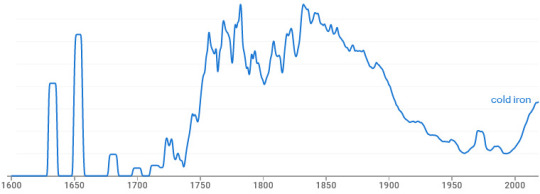
NGram Viewer diagram for 1600-2019.
In other contexts, cold iron is (surprise!) iron that’s not hot. So let’s talk a bit about metallurgy.
Metals

In nature, we can find only one kind of iron that’s pure enough to work with: meteoritic iron. It has to literally fall from the sky. Barring that very rare occurrence, people have to mine the earth for iron ore, which is not workable as is. To separate the iron from the ore we have to smelt it, and for that we need heat, in the form of hot charcoals. Throwing the ore on the coals won’t do much of anything, it’s not hot enough. But if we enclose the coals in a little tower built of clay, leaving holes for air flow, the temperature rises enough to smelt the ore. That’s called a bloomery.
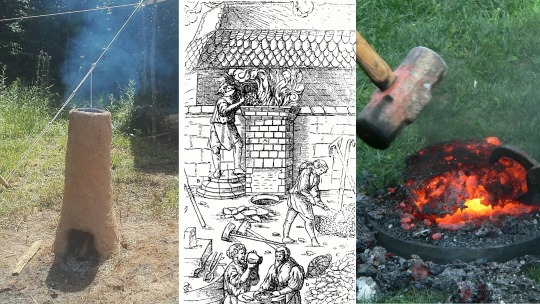
clay bloomery / medieval bloomery / beating the bloom to get rid of the slag
What comes out of the bloomery is a bloom: a porous, malleable mass of iron (that we need) and slag (byproducts that we don’t need). But now we can get rid of the slag and turn the porous mass to something solid, by hammering the hot bloom over and over. And once the slag is off, by the same process we can give it a desired shape in the forge, reheating it as needed. This is called “working” the iron, hence “wrought iron” objects, i.e. forged.
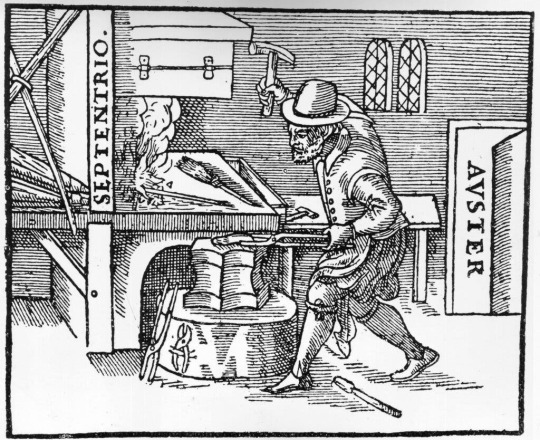
a blacksmith in his forge, with bellows, fire, and anvil (English woodcut, 1603)
This is the lowest-tech version, possibly going back to ~2000 BCE in Nigeria. If we add bellows, the improved air flow will raise the temperature. So smelting happens faster and more efficiently in the bloomery, and so does heating the iron in the forge, making it easier to work with. And that’s the standard process from the Iron Age all through the middle ages and beyond (although in China they may have skipped this stage and gone straight to the next one).
If we make the bloomery bigger and bigger, with stronger and stronger bellows, we end up with a blast furnace, a construction so efficient that the temperature outright melts the iron, and it’s liquified enough to be poured into a mould and acquire the desired shape when it cools off. This is “cast iron”.

a blast furnace
So in all of this, what’s cold iron? Well, it’s iron that went though the heat and cooled off. (No heat = no iron, all you got is ore.) If it came out of a bloomery, or if it wasn’t cast, it’s by definition worked, hammered, beaten, wrought, and that happened while it was still hot.
Is there such a thing as “cold-wrought” iron? No. In fact, “working cold iron” was a simile for something foolish or pointless. A smith who beats cold iron instead of putting it in the fire shows folly, says a 1694 book on religion, so you too should choose your best tools, piety and good decorum, to educate your children and servants, instead of beating them. When Don Quixote (1605) declares he’ll go knight-erranting again, Sancho Panza tries to dissuade him, but it’s like “preaching in the desert and hammering on cold iron” (a direct translation of martillar en hierro frío).
Minor work can be done on cold iron. A 1710 dictionary of technical terms tells us that a rivetting-hammer is “chiefly used for rivetting or setting straight cold iron, or for crooking of small work; but ’tis seldom used at the forge”. Fully fashioning an object out of cold iron is not a real process – though a 1659 History of the World would claim that in Arabia it’s so hot that “smiths work nails and horseshoes out of cold iron, softened only by the vigorous heat of the sun, and the hard hammering of hands on the anvil”. [I declare myself unqualified to judge the veracity of this statement, let's just say I have doubts.] And there is of course such a thing as “cold wrought-iron”, as in wrought iron after it’s cooled off.
Either way, in the context of pre-20th century English texts which refer to apotropaic “cold iron”, it’s definitely not “cold-wrought”, or meteoritic, or a special alloy of any kind. It’s just iron.
Fiction
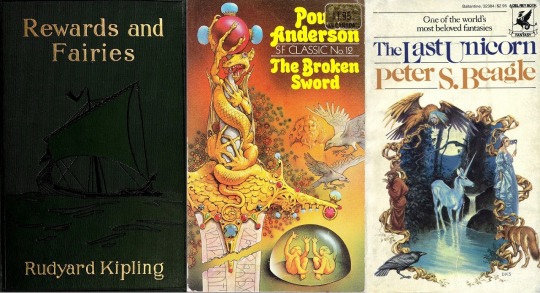
The old superstition kept coming up in fantasy fiction. In 1910 Rudyard Kipling wrote the very influential short story “Cold Iron” (in the collection Rewards and Fairies), where he explains invents the details of the fairies’ aversion to iron. They can’t bewitch a child wearing boots, because the boots have nails in the soles. They can’t pass under a doorway guarded by a horseshoe, but they can slip through the backdoor that people neglected to guard. Mortals live “on the near side of Cold Iron”, because there’s iron in every house, while fairies live “on the far side of Cold Iron”, and want nothing to do with it. And changelings brought up by fairies will go back to the world of mortals as soon they touch cold iron for the first time.
In Poul Anderson’s The Broken Sword (1954), we read:
“Let me tell you, boy, that you humans, weak and short-lived and unwitting, are nonetheless more strong than elves and trolls, aye, than giants and gods. And that you can touch cold iron is only one reason.”
In Peter S. Beagle’s The Last Unicorn (1968) the unicorn is imprisoned in an iron cage:
“She turned and turned in her prison, her body shrinking from the touch of the iron bars all around her. No creature of man’s night loves cold iron, and while the unicorn could endure its presence, the murderous smell of it seemed to turn her bones to sand and her blood to rain.”
Poul Anderson would come back to that idea in Operation Chaos (1971), where the worldbuilding’s premise is that magic and magical creatures have been reintroduced into the modern world, because a scientist “discovered he could degauss the effects of cold iron and release the goetic forces”. And that until then, they had been steadily declining, ever since the Iron Age came along.
There are a million examples, I’m just focusing on those that would have had a more direct influence on roleplaying games. However, I should note that all these say “cold iron” but mean “iron”. Yes, the fey call it cold, but they are a poetic bunch. You can’t expect Robin Goodfellow’s words to be pedestrian, now can you?
RPGs
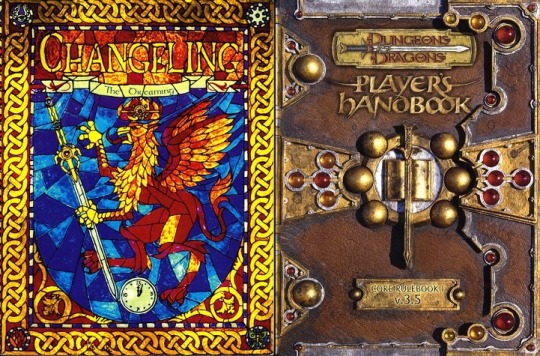
And from there, fantasy roleplaying systems got the idea that Cold Iron is a special material that fey are vulnerable to. The term had been floating around since the early D&D days, but inconsistently, scattered in random sourcebooks, and not necessarily meaning anything else than iron. In 1st Edition’s Monster Manual (1977) it’s ghasts and quasits who are vulnerable to it, not any fey creature. Devils and/or fiends might dislike iron, powdered cold iron is a component in Magic Circle Against Evil, and “cold-wrought iron” makes a couple of appearances. For example, in AD&D it can strike Fool’s Gold and turn it back to its natural state, revealing the illusion.
Then Changeling: The Dreaming came along and made it a big deal, a fundamental rule, and an anathema to all fae:
Cold iron is the ultimate sign of Banality to changelings. ... Its presence makes changelings ill at ease, and cold iron weapons cause horrible, smoking wounds that rob changelings of Glamour and threaten their very existence.... The best way to think about cold iron is not as a thing, but as a process, a very low-tech process. It must be produced from iron ore over a charcoal fire. The resulting lump of black-gray material can then be forged (hammered) into useful shapes. — Changeling: The Dreaming (2nd Edition, 1997)
So now that we know how iron works, does that description make sense? Well, if we assume that the iron ore is unceremoniously dumped on coals, it does not. You can’t smelt iron like that. If we assume that a bloomery is involved even though it’s not mentioned, then yes, this is broadly speaking how iron’s been made since the Iron Age, and until blast furnaces came into the picture. But the World of Darkness isn’t a pseudo-medieval setting, it’s modern urban fantasy. So the implication here is that “cold iron” is iron made the old way: you can’t buy it in the store, someone has to replicate ye olde process and do the whole thing by hand. Now, this is NOT how the term “cold iron” has been used in real life or fiction thus far, but hey, fantasy games are allowed to invent things.
Regardless, 3.5 borrowed the idea, and for the first time D&D made this a core rule. Now most fey creatures had damage reduction and took less damage from weapons and natural attacks, unless the weapon was made of Cold Iron:
“This iron, mined deep underground, known for its effectiveness against fey creatures, is forged at a lower temperature to preserve its delicate properties.” — Player’s Handbook (3.5 Edition, 2003)
Pathfinder kept the rule, though 5e did not. And unlike Changeling, this definition left it somewhat ambiguous if we’re talking about a material with special composition (i.e. not iron) or made with a special process (i.e. iron but). The community was divided, threads were locked over this!
So until someone points me to new evidence, I’ll assume that the invention of cold iron as a special material, distinct from plain iron, should be attributed to TTRPGs.
#long post#cold iron#d&d#Changeling: The Dreaming#World of Darkness#Peter S. Beagle#The Last Unicorn#Rudyard Kipling#Poul Anderson#The Broken Sword#how to rogue#pathfinder#rogues in fiction#Operation Chaos#rogue superstitions#words of the trade#thieves' cant#ad&d#d&d history#1st edition#fey#3.5#fluff#trs
405 notes
·
View notes